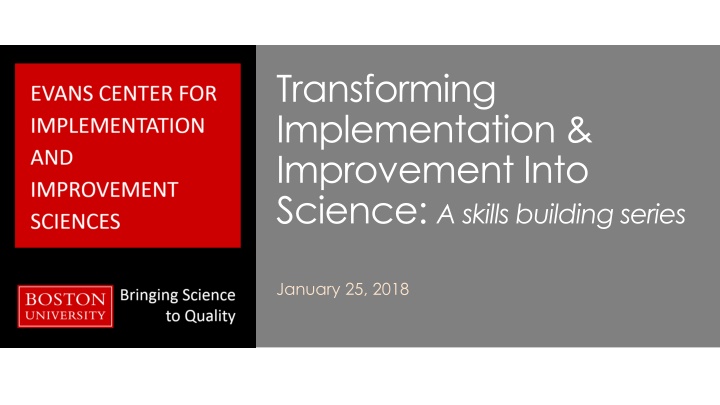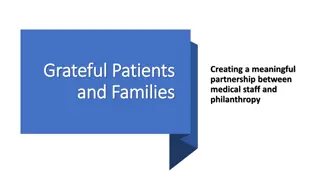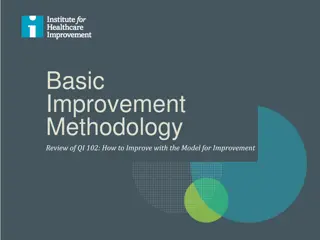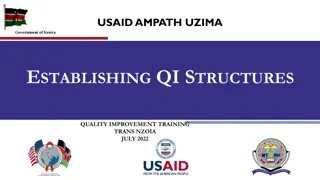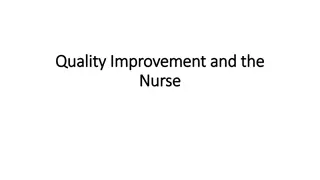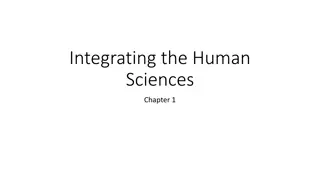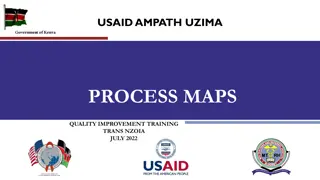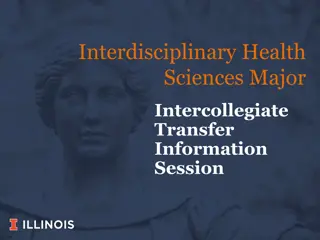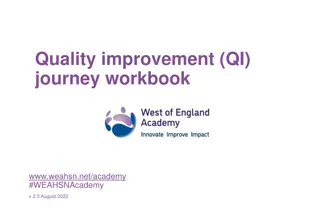Enhancing Healthcare through Implementation and Improvement Sciences
Explore the realms of Implementation Science and Improvement Science in healthcare, focusing on promoting evidence-based practices, rigorously measuring outcomes, and identifying high-quality projects. Learn about key criteria, strategies, and guidance to drive effective change and enhance healthcare delivery.
Download Presentation

Please find below an Image/Link to download the presentation.
The content on the website is provided AS IS for your information and personal use only. It may not be sold, licensed, or shared on other websites without obtaining consent from the author.If you encounter any issues during the download, it is possible that the publisher has removed the file from their server.
You are allowed to download the files provided on this website for personal or commercial use, subject to the condition that they are used lawfully. All files are the property of their respective owners.
The content on the website is provided AS IS for your information and personal use only. It may not be sold, licensed, or shared on other websites without obtaining consent from the author.
E N D
Presentation Transcript
Transforming Implementation & Improvement Into Science: A skills building series January 25, 2018
Engage with CIIS Provide guidance, support & innovation to design projects that rigorously evaluate the effectiveness of efforts to implement change Guide & Innovate Accelerate & Promote Sustainability Identify strategies that accelerate the adoption & promote sustainability of effective healthcare interventions Provide implementation & improvement sciences education to faculty, trainees, students Educate
Overview: Implementation & Improvement Sciences Implementation Science Focuses on optimal strategies to promote evidence uptake in real- world settings Addresses Aims Did stakeholders perform the desired endeavor? Why or why not? How well? Translate research intro practice Systematically implement evidence-based practices Improvement Science Focuses on rigorously measuring outcomes associated with efforts to improve care delivery Addresses Did the new endeavor measurably improve desired outcomes? Improve the quality of healthcare
Identifying High-Quality Projects Issues Applying NIH Criteria to Implementation & Improvement (IIS) Main NIH Criteria Overall impact Significance Innovation Approach Investigator team Research environment Broad, non-specific to IIS Criteria could be operationalized to better describe high-quality IIS
Proctors 10 Key Ingredients NIH Criteria Proctor s 10 Key Ingredients for Implementation Research Proposals Quality/care gap Evidence-based treatment Conceptual model, theoretical justification Stakeholder priorities, engagement in change Impact; Significance Significance; Innovation Approach; Innovation Impact; Approach; Research Environment Setting s readiness to adopt new services Implementation strategy/process Team experience with the setting, treatment, processes Impact; Approach; Environment Impact; Significance; Innovation Approach; Investigator Team Feasibility of proposed research design Measurement & analysis section Policy/funding environment; support for sustaining change Approach; Investigator Team Approach; Investigator Team Impact; Significance Source: Writing Implementation Research Grant Proposals: Ten Key Ingredients. Proctor EK, Powell BJ, Baumann AA, Hamilton AM, Santerns RL. Implementation Science. 2012;7:96.
Upcoming Sessions Tentative Date 10/25/2017 Session Title Proposal Areas Addressed Quality/Care Gap, Evidence- Based Practice Conceptual Model Identifying Your Implementation & Improvement Sciences Research Question Using & Discussing Implementation Science Models Implementation Strategies Versus Study Interventions Designing an Implementation & Improvement Sciences Study Designing Your Implementation & Improvement Sciences Study Measuring Implementation & Improvement Outcomes Engaging with Stakeholders to Conduct Feasible & Meaningful Research 12/6/2017 1/25/2018 Implementation Strategy 2/28/2018 Study Design 3/22/2018 Study Design [PRACTICE-BASED SESSION] Outcomes, Quantitative & Qualitative Methods Stakeholder Engagement, Feasibility, Team, Policy Environment 4/18/2018 5/10/2018
Series Goal Proctor s 10 Key Ingredients High-Quality Implementation & Improvement Sciences Significant Contributions to Improve Care, Advance Fields CIIS Educational Series
Implementation Strategies vs. Interventions Differentiate between implementation strategies & intervention components Discuss how to link implementation strategies to study aims, setting, process & outcome measures Provide examples of how to navigate challenges associated with chosen implementation strategies
Implementation Strategies vs. Study Interventions Megan McCullough, PhD Research Health Scientist Center for Healthcare Organization & Implementation Research (CHOIR) ENRM Veterans Hospital
VA Disclaimer The views expressed in this presentation are those of the authors and do not necessarily reflect the position or policy of the Department of Veterans Affairs or the U.S. government.
What is an Evidence-Based Intervention? Interventions with proven efficacy and effectiveness at improving health behaviors, health outcomes, or health- related environments Intervention could include programs, practices, policies & guidelines Rabin, B. A., Brownson, R. C., Haire-Joshu, D., Kreuter, M. W., & Weaver, N. L. (2008). A glossary for dissemination and implementation research in health. Journal of Public Health Management and Practice, 14(2), 117-123.; Brown CH, Curran G, Palinkas LA, Aarons GA< Wells KB, Jones L., et al. An overview of research and evaluation designs for dissemination and implementation. Annu Rev Public Health,. 2017; 38:1-22
Implementation Research/Strategies Implementation research: scientific study of the use of strategies to adopt & integrate evidence-based health interventions into clinical and community settings in order to improve patient/population outcomes Methods or techniques used to enhance adoption, implementation, & sustainability of a clinical program or practice (Proctor et al., 2013) (Proctor et al., 2009) Proctor EK, Powell BJ, McMillen JC. Implementation Strategies: Recommendations for Specifying and Reporting. Implementation Science. 2013;1(8):139.; Proctor EK, Landsverk J, Aarons G, Chambers D, Glisson C, Mittman B. Implementation Research in Mental Health Services: An Emerging Science with Conceptual, Methodological, and Training challenges. Administration and Policy in Mental Health and Mental Health Services Research. 2009;36(1):24-34. doi:10.1007/s10488-008-0197-4.
Recommendations for Specifying & Reporting The actor (who enacts the strategy) The action (use active verb statement to specify the specific actions, steps, or processes that need to be enacted) Action target (specify targets and identify units of analysis) Temporality (when the strategy is used) Dosage Implementation outcome affected Justification Name the strategy Define the strategy Specify the strategy Proctor EK, Powell BJ, McMillen JC. Implementation Strategies: Recommendations for Specifying and Reporting. Implementation Sicence. 2013;1(8):139.
Questions? Thoughts? Discussion?
Operationalizing an Example: The Anticoagulation Clinic Improvement Initiative (ACCII) Hybrid Study Type 2
ACCII Study: Overview Use evidence-based dosing algorithm Algorithm linked to improve percent time in therapeutic range (TTR) Higher TTR = improved patient outcomes Use a dashboard to measure site-level TTR & related process measures Utilize improvement approaches to increase standardization across facilities Appoint an ACC Coordinators (internal facilitators) from each site to facilitate change
Promoting Action on Research Implementation in Health Services (PARIHS) Framework Evidence: Stakeholder s perception of validity of intervention & EBP algorithm Facilitation: Concerned with enabling & supporting the implementation of an intervention through deployment of EF & IF Context: Environment where ACCII is introduced: may be more or less receptive to change Implementation
ACCII Study: Bundle of Implementation Strategies How we got the intervention implemented (Powell et al., 2015) Local needs assessment Ongoing training Create a learning collaborative Inform local opinion leaders Ongoing consultation Tailor strategies Visit other sites Develop a formal implementation blueprint Assess for readiness Blended facilitation (focus today) Stakeholder engagement Plan Do Study Act (PDSA) cycles Educational outreach visits Powell BJ, Walz TJ, Chinman MJ, Damschroder LJ, Smith JL, Matthieu MM, Proctor EK, Kircher JE. A Refined Compilation of Implementation Strategies: Results from the Expert Recommendations for Implementing Change (ERIC) Project. Implementation Science. 2015;10:21.
ACCII Study: Methods Semi-Structured Interviews Annual interviews over 4 years with Internal Facilitators (ACC coordinators), all ACC staff at 8 VA hospitals Interviews with External Facilitation Team 2 sets of interview with pharmacy leadership Qualitative Deductiveapproach using PARIHS framework & emergent thematic analysis (inductive) Assessed/measured implementation outcomes Quantitative Interrupted time series to measure site & VISN level TTR along with key process measures (outcome measures)
ACCII Study: Participants # Internal Facilitator Interviews 11 12 12 12 47 # External Facilitator Interviews # Main Study Interviews Year 1 2 3 4 Total 67 63 67 57 254 5 5
ACCII Study: Intervention & Strategy Exploration of intervention & strategy together ACCII example: blended facilitation
ACCII Study: External Facilitation Strategies Organize face-to-face meeting quarterly for ACC coordinators Introduced ACC coordinators to: LEAN Process mapping PDSAs & other quality improvement skills Implementation strategies Work 1:1 with ACC coordinators Audit & feedback for ACC coordinators Facilitate bi-monthly calls for ACC coordinators Facilitate ACC journal club Annual site visits with focused improvement work Enlist stakeholders to support ACCII Draft policy documents & shepherd policy proposals through committees for approval
ACCII Study: Internal Facilitation Strategies Organize face-to-face meeting quarterly to learn: Quality improvement approaches Process mapping & evaluation Group activities to standardize & centralize Twice monthly ACC Coordinator s calls Work 1:1 with external facilitation staff Site visit to Portland, OR to visit top performing VA ACC Facilitating implementation of ACCII at home site Serving as resource/support for frontline staff during ACCII
ACCII Study: Implementation Outcomes What are the challenges? How have you measured these in your projects?
Uptake of Intervention ACCII Study: Uptake of Intervention Clinical Intervention Uptake Levels Medium Algorithm is inconsistently used among staff High Low ACC Dosing Algorithm Algorithm is implemented & used a high percentage of the time by all staff Dashboard is used not only to measure performance, but as a tool for targeting patients needing more attention Most or all staff increasing use of dashboard Algorithm is rarely used among all staff Dashboard Dashboard is used to measure performance & only 1-2 features used inconsistently as a tool Dashboard used rarely to measure performance & rarely or not at all as a tool Often only select staff use the dashboard with little or no general usage Little to no general usage & little or no select staff usage Time in Therapeutic Range (TTR) TTR improves TTR shows some improvement TTR shows little improvement McCullough MB, Gillespie C, Petrakis BA, Jones, EA, Park AM, Lukas CVD, Rose AJ. Forming and Activating an Internal Facilitation Group for Successful Implementation: A Qualitative Study. Research in Social and Administrative Pharmacy. 2017:1-14.
Implementation Outcomes ACCII Study: Uptake of Intervention Participation in Activities: Uptake Levels Medium Site inconsistently sends IF to participate High Low ACC Coordinators IF Group Site regularly sends appropriate IF to participate Staff regularly participate & contribute IF has staff regularly participate Site rarely or never sends IF to participate Journal Club (IF, staff) Staff unevenly participate & contribute IF has staff inconsistently participate IF inconsistently elicits feedback Staff rarely or never participate & contribute IF has staff rarely participate PDSA cycles related to ACC improvement led by IF IF facilitates feedback from frontline staff to EF on implementation work Site seeks out &/or accepts assistance by EF ACC Improvement Team IF regularly elicits feedback IF rarely participate IF & site reach out for assistance & remain in contact with EFs IF & site unevenly reach out for assistance from EFs IF & site do not reach out for assistance, does not respond to EFs offers of assistance McCullough MB, Gillespie C, Petrakis BA, Jones, EA, Park AM, Lukas CVD, Rose AJ. Forming and Activating an Internal Facilitation Group for Successful Implementation: A Qualitative Study. Research in Social and Administrative Pharmacy. 2017:1-14.
ACCII Study: Outcome Measures Thoughts? Discussion on importance of outcome measures
ACCII Study: Outcome Measures Rose AJ, Park A, Gillespie C, Lukas CVD, Ozonoff A et al. Results of a Regional Effort to Improve Warfarin Management. Annals of Pharmacology. 2017.
ACCII Study: Outcome Measures Rose AJ, Park A, Gillespie C, Lukas CVD, Ozonoff A et al. Results of a Regional Effort to Improve Warfarin Management. Annals of Pharmacology. 2017.
ACCII Study: Outcome Measures Abbreviations: TTR: Time in Therapeutic Range VISN: Veterans Integrated Service Network Rose AJ, Park A, Gillespie C, Lukas CVD, Ozonoff A et al. Results of a Regional Effort to Improve Warfarin Management. Annals of Pharmacology. 2017.
ACCII Study: Overall Results for Blended Facilitation Sites with greater improvement were distinguished by 3 factors: Full participation in internal facilitation team is key to successful implementation 1 Being an internal facilitator and the challenges of encouraging change in frontline staff 2 Greater support from site-level managers and superiors lead to high uptake levels 3
ACCII Study: Implications Blended facilitation can serve as an effective implementation strategy Findings can help guide researchers who seek to incorporate internal facilitator groups as part of their implementation strategies Contributes to a growing literature regarding which implementation strategies work best and under what circumstances
Key Takeaways Implementation strategies: Methods used to adopt, integrate evidence-based interventions Be specific when describing strategies Actors, actions, target, time, dose, outcome, justification Conceptual models can help identify & map strategies to study aims, setting, outcome measures
Tell Me About Your Projects What is your evidence- based intervention? Framework & study design? What strategies would you use to get the intervention into practice? How do you determine an intervention versus a strategy? What are the measures? Outcome measures? Implementation measures? Where do you get stuck? What is a puzzle here that is hard to sort out and solve?
Upcoming Sessions Tentative Date 10/25/2017 Session Title Proposal Areas Addressed Quality/Care Gap, Evidence- Based Practice Conceptual Model Identifying Your Implementation & Improvement Sciences Research Question Using & Discussing Implementation Science Models Implementation Strategies Versus Study Interventions Designing an Implementation & Improvement Sciences Study Designing Your Implementation & Improvement Sciences Study Measuring Implementation & Improvement Outcomes Engaging with Stakeholders to Conduct Feasible & Meaningful Research 12/6/2017 1/25/2018 Implementation Strategy 2/28/2018 Study Design 3/22/2018 Study Design [PRACTICE-BASED SESSION] Outcomes, Quantitative & Qualitative Methods Stakeholder Engagement, Feasibility, Team, Policy Environment 4/18/2018 5/10/2018
Thank You! Contact CIIS Website: http://sites.bu.edu/ciis/ Email: ciisinfo@bu.edu
